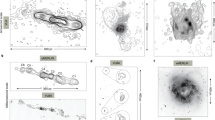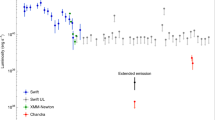Abstract
THE radio source Cassiopeia A is well known to be associated with the remnants of a galactic supernova. Although optical studies are difficult because of heavy obscuration the object is seen to consist of a roughly circular nebulosity with an angular diameter of 4 min of arc. Minkowski1–3 has investigated the motions of the filaments and estimated the date of the explosion as AD 1702 ± 14. It is natural to expect a secular variation of flux density from so young an object and, following Minkowski's work, a mean rate of decrease of (1.06 ± 0.14) per cent per year was detected by Högbom and J. R. S.4 by means of observations in 1956 and 1960 combined with earlier observations by Ryle in 1948–9. Measurements at other frequencies have since been reported5–9 which confirm that there is a decrease but do not improve the accuracy of measurement.
This is a preview of subscription content, access via your institution
Access options
Subscribe to this journal
Receive 51 print issues and online access
$199.00 per year
only $3.90 per issue
Buy this article
- Purchase on Springer Link
- Instant access to full article PDF
Prices may be subject to local taxes which are calculated during checkout
Similar content being viewed by others
References
Minkowski, R., IAU Symp. No. 4 (1955), 107 (edit. by van de Hulst, H. C.) (Cambridge University Press, 1957).
Minkowski, R., Paris Symp. on Radio Astronomy 1958 (edit. by Bracewell, R. N.), 315 (Stanford University Press, 1959).
Minkowski, R., Nebulae and Interstellar Matter (edit. by Middlehurst, B. M., and Aller, L. H.) (University of Chicago Press, 1968).
Högbom, J. A., and Shakeshaft, J. R., Nature, 189, 561 (1961).
Heeschen, D. S., and Meredith, B. L., Nature, 190, 705 (1961).
Lastochkin, V. P., and Stankevich, K. S., Astro. Zhur., 41, 769 (1964).
Mayer, C. H., McCullough, T. P., and Sloanaker, R. M., Astrophys. J., 141, 867 (1965).
Findlay, J. W., Hvatum, H., and Waltmann, W. B., Astrophys. J., 141, 873 (1965).
Sanamjan, V. A., and Aslanjan, A. M., Astrofizica, 1, 247 (1965).
Ryle, M., J. Inst. Elect. Eng., 6, 14 (1960).
Parker, E. A., Mon. Not. Roy. Astron. Soc., 138, 407 (1968).
Shklovsky, I. S., Astro. Zhur., 37, 256 (1960).
Kellermann, K. I., and Pauliny-Toth, I. I. K., Ann. Rev. Astron. Astrophys., 6, 417 (1968).
Shklovsky, I. S., Supernovae, 7 (John Wiley and Sons Ltd, 1968).
Brosche, P., Sterne u. Weltraum, 6, 198 (1967).
Author information
Authors and Affiliations
Rights and permissions
About this article
Cite this article
SCOTT, P., SHAKESHAFT, J. & SMITH, M. Decrease of Flux Density of the Radio Source Cassiopeia A at 81.5 MHz. Nature 223, 1139–1140 (1969). https://doi.org/10.1038/2231139a0
Received:
Issue Date:
DOI: https://doi.org/10.1038/2231139a0
This article is cited by
-
Radio radiation of the Casseopeia a and Crab nebula supernova remnants from results of absolute measurements in the meter wavelength range
Radiophysics and Quantum Electronics (1988)
-
Absolute flux scale for radioastronomy (review)
Radiophysics and Quantum Electronics (1986)
-
Radio emission from the remnant of the supernova Cassiopeia-A
Radiophysics and Quantum Electronics (1973)
-
The secular behavior of X-ray and radio emission from supernova remnants
Astrophysics and Space Science (1970)
Comments
By submitting a comment you agree to abide by our Terms and Community Guidelines. If you find something abusive or that does not comply with our terms or guidelines please flag it as inappropriate.



